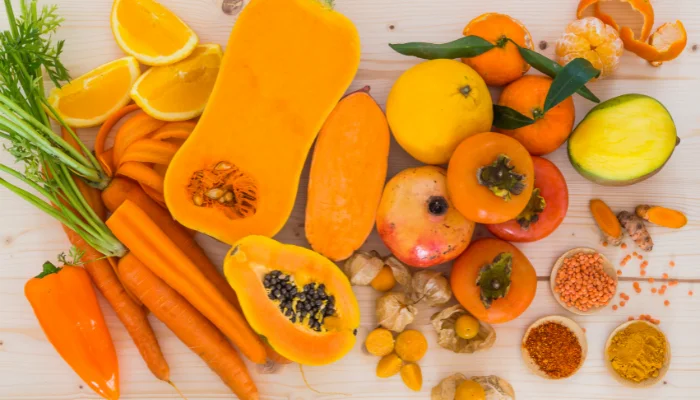A range of vibrant fruits and vegetables must be included in your diet if you want to keep it healthy.
Each color family provides a special combination of vitamins, minerals, and antioxidants that improve general health.
We’ll delve into the world of orange fruits and veggies in this blog post, learning about their health advantages and mouthwatering ways to eat them.
Orange is more than just a color; it also represents life, vigor, and warmth.
It makes sense that many foods with orange hues are rich in nutrients that can improve your health and immune system.
List Of Fruits And Vegetables That Are Orange
-
Sweet Potatoes
Sweet potatoes are a beloved orange vegetable that is rich in beta-carotene, an antioxidant that converts to vitamin A in the body.
Vitamin A is essential for healthy skin, vision, and immune function. In addition to vitamin A, sweet potatoes provide fiber, potassium, and vitamins C and B6.
Roast them, make sweet potato fries, or add them to soups and stews for a comforting and nutritious meal.
-
Carrots
Carrots are perhaps one of the most well-known orange vegetables.
They are loaded with beta-carotene and are known for their benefits for eye health. Carrots also contain fiber, vitamin K, and potassium.
Enjoy them raw as a snack, add them to salads, or incorporate them into your favorite dishes for a satisfying crunch and a boost of nutrients.
-
Oranges
Oranges, the namesake of the color itself, are a citrus fruit that needs no introduction.
They are a prime source of vitamin C, which supports immune health and acts as a powerful antioxidant.
Oranges are also rich in dietary fiber and provide hydration with their high water content.
Enjoy them as a refreshing snack or squeeze them for fresh orange juice to start your day.
-
Pumpkins
Pumpkins are not just for carving jack-o’-lanterns. They are a fantastic source of beta-carotene and a range of other nutrients like vitamin C, potassium, and fiber.
Pumpkin puree can be used in both sweet and savory dishes, from pumpkin pies and muffins to soups and roasted sides.
-
Cantaloupe
Cantaloupe is a juicy and delicious orange fruit packed with vitamins A and C.
It’s also a great source of hydration due to its high water content.
Enjoy cantaloupe as a refreshing addition to fruit salads, smoothies, or simply on its own for a sweet and hydrating treat.
-
Apricots
Apricots are small, golden-orange fruits that are high in vitamin A and vitamin C.
They are also a good source of dietary fiber and potassium. Whether eaten fresh, dried, or as a jam, apricots offer a sweet and nutritious flavor.
-
Papayas
Papayas are tropical fruits with a vibrant orange flesh that is rich in vitamins A and C.
They also contain the enzyme papain, which aids in digestion. Add papaya chunks to fruit salads or blend them into smoothies for a taste of the tropics.
-
Butternut Squash
Butternut squash is a versatile orange vegetable that’s rich in beta-carotene, vitamins A and C, potassium, and fiber.
Its sweet, nutty flavor makes it a favorite for soups, stews, and roasted side dishes.
-
Mangoes
Mangoes are tropical fruits that not only add a burst of bright orange color to your plate but also provide an abundance of vitamins A and C.
They’re delicious when eaten fresh, blended into smoothies, or added to salsas and salads.
-
Persimmons
Persimmons are orange fruits that are high in vitamin A, vitamin C, and dietary fiber.
They have a unique sweet and slightly spicy flavor. Enjoy them fresh, or use them in baking and desserts.
-
Kumquats
Kumquats are small, orange citrus fruits that you can eat whole, including the peel.
They are rich in vitamin C and fiber. Their sweet-tart flavor makes them a delightful addition to salads or as a tangy snack.
-
Orange Bell Peppers
Orange bell peppers are not only vibrant in color but also packed with vitamins A and C.
They add a sweet, crunchy element to salads, stir-fries, and sandwiches.
-
Hubbard Squash
Hubbard squash is a large, winter squash that’s dense and sweet. It’s high in beta-carotene, vitamins A and C, and fiber.
Roasting or pureeing it makes for a hearty and nutritious addition to your meals.
-
Tangerines
Tangerines are similar to oranges but smaller and easier to peel.
They are rich in vitamin C and are a convenient, portable snack option.
-
Orange Tomatoes
Orange tomatoes are a type of tomato with a striking orange color, commonly referred to as “heirloom” tomatoes.
They are a good source of potassium, vitamin C, and the antioxidant lycopene, which may support heart health.
Eat them as a pizza topping, in salads, or in sandwiches.
Wrap Up
These fruits and vegetables’ vivid orange coloring is not only eye-catching but also a sign of their great nutritional worth.
Improved vision, a stronger immune system, and improved digestion are just a few of the health advantages of having orange-hued fruit in your diet.
In order to give your diet the power of orange, remember to pick up some sweet potatoes, carrots, oranges, pumpkins, cantaloupes, apricots, or papayas the next time you’re at the grocery store or farmers’ market.
These wholesome foods will enhance the flavor and vibrancy of your meals whether you consume them raw, roasted, pureed, or combined.




